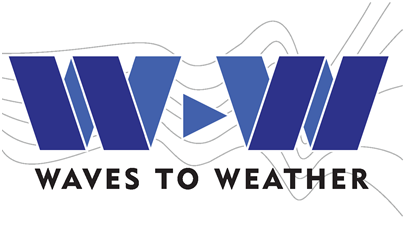Run/Init: {{ run_date }}
Keyboard Navigation (click on map if not working): ↓-12h ↑+12h ←→ Swap Model
00/12UTC runs update around 12:30/00:30UTC
Welcome to the Equatorial Wave Identification Tool, designed to analyze operational global deterministic forecasts from IFS, ICON and GFS, alongside satellite rainfall data from GPM IMERG. This tool employs two distinct methods to isolate Equatorial Waves (EWs) and provides users with valuable insights into tropical dynamics. Figures feature the raw fields in the background, complemented by contours highlighting the filtered EWs.
Method 1 (WK): Wavenumber–Frequency Filtering using Fast Fourier Transform
Introduced by Wheeler and Kiladis (1999), this method utilizes the Fast Fourier Transform (FFT) for spectrally isolating the EWs in wavenumber and frequency domains for eastward and westward propagating signals. The operational padded filtering approach, developed by Janiga et al. (2018), is applied here on 12-hourly temporal and 1 ° spatial data resolution. The method is applied on 2 years of ERA5 reanalysis data padded with 10 days of analysis, 10 days of forecast model data, and zeros, creating a four-year dataset. The filtering process extracts forecasts, isolating five different EW types: Kelvin waves, Mixed Rossby-Gravity waves (MRG), Equatorial Rossby waves (ER), Tropical Disturbances (TD), and the Madden Julian Oscillation (MJO). The isolation occurs in zonal (U) and meridional (V) wind fields at 200hPa and 850hPa across various latitudinal bands. For GPM IMERG, 2 years of observations are padded with 2 years of zeros, and the forecasts are derived by isolating the residual signal present in the zero-padded section after filtering.
Method 2 (Yang): 2D Spatial Projection using Parabolic Cylinder Functions
Introduced by Yang et al. (2003), this method involves a 2D spatial projection of upper and lower tropospheric dynamical fields onto equatorial wave modes. The method is applied to 6-hourly temporal and 1 ° spatial resolution data on a total of 30 days data consisting of a combination of reanalysis (ERA5), analysis and forecast fields. The method is applied to the two zonal and meridional horizontal-velocity (U,V) fields at 850 hPa and 200 hPa simultaneously. The projection method extracts different wave types, including Kelvin waves, Westward-moving Mixed Rossby Gravity waves (WMRG), Equatorial Rossby waves with meridional modes R1 and R2.
The implementation of the EW identification and scripting for the maps production was done by Maurus Borne. The forecast data download, page design and navigation logic was done by Marco Wurth.
The work was supported by the DFG Transregio Waves to Weather.
Method 1 (WK): Wavenumber–Frequency Filtering using Fast Fourier Transform
Introduced by Wheeler and Kiladis (1999), this method utilizes the Fast Fourier Transform (FFT) for spectrally isolating the EWs in wavenumber and frequency domains for eastward and westward propagating signals. The operational padded filtering approach, developed by Janiga et al. (2018), is applied here on 12-hourly temporal and 1 ° spatial data resolution. The method is applied on 2 years of ERA5 reanalysis data padded with 10 days of analysis, 10 days of forecast model data, and zeros, creating a four-year dataset. The filtering process extracts forecasts, isolating five different EW types: Kelvin waves, Mixed Rossby-Gravity waves (MRG), Equatorial Rossby waves (ER), Tropical Disturbances (TD), and the Madden Julian Oscillation (MJO). The isolation occurs in zonal (U) and meridional (V) wind fields at 200hPa and 850hPa across various latitudinal bands. For GPM IMERG, 2 years of observations are padded with 2 years of zeros, and the forecasts are derived by isolating the residual signal present in the zero-padded section after filtering.
Method 2 (Yang): 2D Spatial Projection using Parabolic Cylinder Functions
Introduced by Yang et al. (2003), this method involves a 2D spatial projection of upper and lower tropospheric dynamical fields onto equatorial wave modes. The method is applied to 6-hourly temporal and 1 ° spatial resolution data on a total of 30 days data consisting of a combination of reanalysis (ERA5), analysis and forecast fields. The method is applied to the two zonal and meridional horizontal-velocity (U,V) fields at 850 hPa and 200 hPa simultaneously. The projection method extracts different wave types, including Kelvin waves, Westward-moving Mixed Rossby Gravity waves (WMRG), Equatorial Rossby waves with meridional modes R1 and R2.
The implementation of the EW identification and scripting for the maps production was done by Maurus Borne. The forecast data download, page design and navigation logic was done by Marco Wurth.
The work was supported by the DFG Transregio Waves to Weather.


